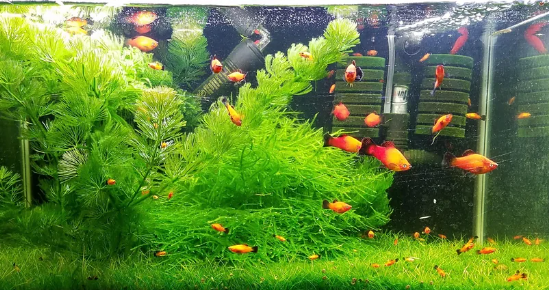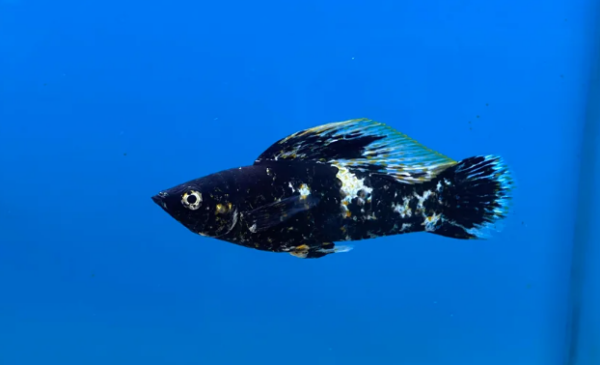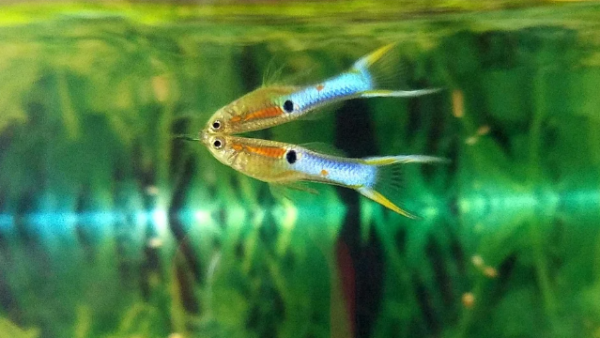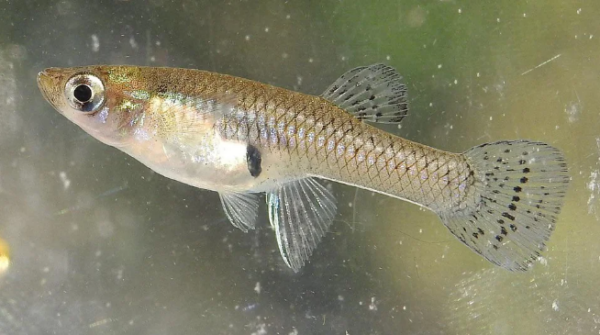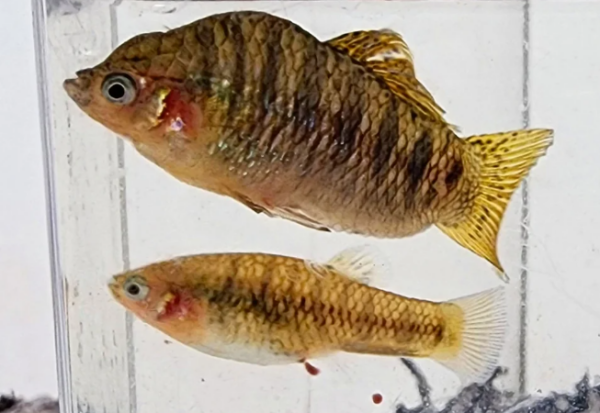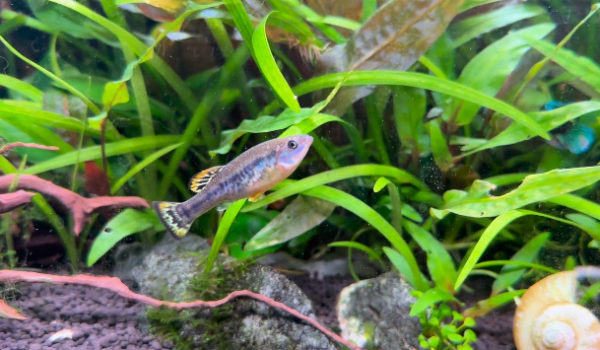External fertilization, thanks to the vastness of natural water bodies, is more successful in the wild. Yet it often fails in artificial confined waters because of predation and lack of appropriate care.
Internal fertilization, on the other hand, has a better success rate than egg-laying species in most non-professional aquarium setups.
Known for this particular characteristic and sometimes coloration, livebearer fishes give birth to free-swimming juveniles.
In most cases, a modified anal fin, called gonopodium, works as the male reproductive organ to transfer milt to the female to facilitate the process.
In this article, we’ll go through the top 10 livebearer fish species and briefly discuss their origin, care requirements, feeding habits, and breeding setups.
Table of Contents
Top 10 Livebearer Fish
1. Guppies
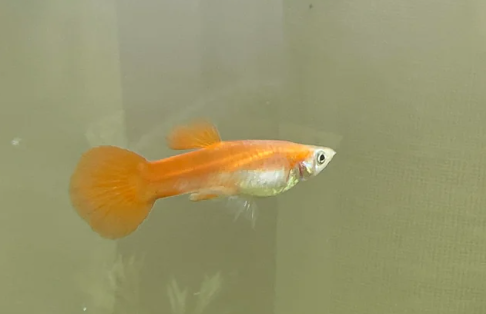
| Information Chart | Guppy |
| Scientific Name: | Poecilia reticulata |
| Family: | Poeciliidae |
| Care Level: | Easy |
| Temperament: | Peaceful. Males can be territorial. |
| Color: | Various colors and patterns. Including red, green, blue, yellow. |
| Lifespan: | 1.5 to 3 years |
| Size: | 1.5 to 2 inches. Females are slightly larger. |
| Diet: | Omnivorous diet |
| Minimum Tank Size: | 10 gallons for a small group |
| Temperature: | 72 to 78 F |
| WaterConditions: | pH: 7.0 to 8.0Moderately hard water |
| Tank Mate Compatibility | Other guppies and peaceful community fish of similar size. |
Guppies are one of the most enticing beginner-schooling fish species, with vibrant coloration and intricate patterns all over their bodies and fins. They’re native to freshwater rivers in the South American countries of Brazil, Guyana, and Venezuela but can now naturally be found in different parts of the globe.
They’re relatively easy to care for and thrive on a 7.0 to 8.0 pH and 72 to 78 degrees F temperature. A well-filtered planted tank emulating their natural habitat further reduces stress and encourages better coloration and growth.
Being omnivorous, adult guppies can be fed a balanced diet of pellets, flakes, and occasional live treats.
Guppies are prolific breeders. Maintaining a ratio of two females to each male often encourages results in successful mating and childbirth. It is usually a safe bet to provide enough hiding space for the young to hide as the adult guppies may try to eat them.
2. Southern Platies
| Information Chart | Southern Platyfish |
| Scientific Name: | Xiphophorus maculatus |
| Family: | Poeciliidae |
| Care Level: | Easy |
| Temperament: | Peaceful |
| Color: | Comes in various colors, including orange, black, and blue. |
| Lifespan: | 3 to 5 years |
| Size: | 2.5 to 3 inches |
| Diet: | Omnivorous |
| Minimum Tank Size: | 10 gallons for a small group |
| Temperature: | 70 to 78 F |
| WaterConditions: | pH: 7.0 to 8.0 Moderate water hardness |
| Tank Mate Compatibility | Other Platies and peaceful community fish |
With large, striking eyes and slapdash color patterns throughout its body, the Platy is a freshwater livebearer fish native to Veracruz, Mexico, and Belize. They inhabit slow rivers and streams with dense vegetation. Platies are pretty suitable as beginner fish for their resiliency and capability to survive under unfavorable water conditions.
In aquariums, a water temperature of 28-78 degrees F or 22-26 degrees C and a slightly alkaline pH of 7.0 to 8.0 is optimum for Platies. Adequate filtration and natural plants should also be considered when keeping Platies in groups and with other community fish.
Platies are mostly omnivorous. A balanced diet of pellets and flakes enhances coloration and promotes growth. Occasional diets of daphnia and bloodworms may also be considered.
The livebearer Platies are pretty easy to breed in aquariums. A ratio of 2:1 females to males is optimum to preserve the health of the females.
Also Read: Bichir: Full Care Guide, Breeding, Tank Size & Disease
3. Mollies
| Information Chart | Molly |
| Scientific Name: | Poecilia sphenops |
| Family: | Poeciliidae |
| Care Level: | Moderate |
| Temperament: | Peaceful, but males can be territorial during breeding seasons |
| Color: | Various colors, including black, white, and orange. |
| Lifespan: | 3 to 5 years |
| Size: | 3 to 4 inches. Larger varieties grow even larger. |
| Diet: | Omnivorous |
| Minimum Tank Size: | 20 gallons for a small group |
| Temperature: | 72 to 78 F |
| WaterConditions: | pH: 7.5 to 8.5 Moderately high water hardness |
| Tank Mate Compatibility | Other peaceful community fish |
Named after their original (since renamed) scientific genus name of Mollienisia, the Mollies are hardy freshwater fish with a large dorsal sailfin and beautiful coloration. Mollies are endemic to the slow-moving freshwater and brackish waters of the Southern US and Mexico. They’re considered one of the most popular feeder fish for their ability to rapidly reproduce.
Generally, Mollies are comfortable living in temperatures between 72-78 degrees F or 22-26 degrees C, but they can tolerate a few degrees of warmer water without any issues. Their adaptability and prolific breeding habits make them pretty suitable for beginner aquarium enthusiasts.
Similar to other species of the Poeciliidae family, Mollies thrive on omnivorous diets. You may feed them daphnia, bloodworms, and live/frozen food, in addition to commercial pellets and flakes.
4. Swordtails
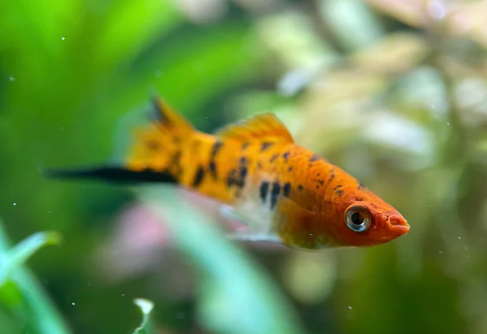
| Information Chart | Swordtail |
| Scientific Name: | Xiphophorus hellerii |
| Family: | Poeciliidae |
| Care Level: | Easy |
| Temperament: | Peaceful. Males can be territorial. |
| Color: | Metallic green, red, orange, and black. |
| Lifespan: | 3 to 5 years |
| Size: | 4 to 6 inches |
| Diet: | Omnivorous |
| Minimum Tank Size: | 30 gallons for a community of Swordtails |
| Temperature: | 72 to 78 F |
| WaterConditions: | pH: 7.0 to 8.2 Moderate to soft water |
| Tank Mate Compatibility | Other Swordtails and peaceful community fish. |
Identified by their distinctive sword-like extension of the lower part of their tails, Swordtails are easy to care for and look pretty amazing in aquarium setups. They’re popular in the aquarium trade for their vibrant coloration and unique appearance.
Swordtails are native to Veracruz, Mexico, and northwestern Honduras in Central and North America. However, they’ve invaded several parts of the world, including Southern Africa and the Australian East Coast, through unethical release in the wild.
Although quite resilient, a slightly alkaline water chemistry is preferred by Swordtails with a pH range of 7.0 to 8.2. Furthermore, a tropical water temperature between 72-78F or 22-26C is optimum for them to thrive and breed.
Swordtails exhibit slight dimorphism with the sword-like tails being more prominent in the males. They also can crossbreed with the Platies in captive waters. Being livebearers, they’re prolific breeders and are comfortable breeding in a 2:1 female-to-male ratio.
5. Endler’s Livebearer
| Information Chart | Endler’s Livebearer |
| Scientific Name: | Poecilia wingei |
| Family: | Poeciliidae |
| Care Level: | Easy |
| Temperament: | Peaceful |
| Color: | Vibrant colors in shades of red, orange, blue, and green. |
| Lifespan: | 2 to 3 years |
| Size: | 1 to 1.5 inches |
| Diet: | Omnivorous |
| Minimum Tank Size: | 5 to 10 gallons for a group |
| Temperature: | 72 to 78 F |
| WaterConditions: | pH: 6.5 to 7.5Soft water hardness |
| Tank Mate Compatibility | Other peaceful community fish species |
Closely resembling and relating to the Guppies, the Endler’s Livebearer is a small colorful fish native to the Paria Peninsula in Venezuela. Endlers are capable of crossbreeding with Guppies and are sold in pet stores typically as Endler’s Guppies. Multiple hybrid species, such as Staeck Endler and Japan Blue Endler, can be found all over the world in aquariums.
Endlers often exhibit iridescent hues and unique patterns slightly different from Guppies. They also are smaller than the latter. A mostly neutral pH range of 6.5 to 7.5 is preferred by the Endlers, but they can tolerate mild deviations.
Despite their omnivorous diet, their small limits their ability to eat pellets or larger flakes. It’s advised to crush the flakes before feeding your Endlers. Microworms, daphnia, and brine shrimp are alternative food choices.
Owing to their smaller size, Endler fry are often subjected to tank predation. Consider offering them adequate vegetation and decorations for them to hide. Similar to other livebearer species, a female-to-male ratio of 2:1 is optimum.
Also Read: The Best Fish For 3 Gallon Tank
6. Wrestling Halfbeaks
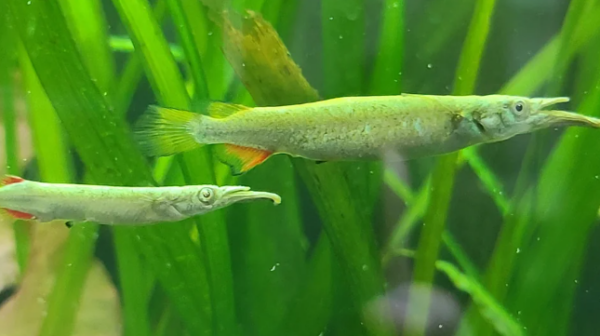
| Information Chart | Wrestling Halfbeaks |
| Scientific Name: | Dermogenys pusilla |
| Family: | Zenarchopteridae |
| Care Level: | Moderate |
| Temperament: | Peaceful. Males can be territorial during breeding. |
| Color: | Silver body with distinct coloration |
| Lifespan: | 2 to 3 years |
| Size: | 2 to 3 inches |
| Diet: | Omnivorous |
| Minimum Tank Size: | 20 gallons for a group |
| Temperature: | 75 to 82F |
| WaterConditions: | pH: 6.5 to 8.0 Moderate water hardness |
| Tank Mate Compatibility | Peaceful community fish |
Silver white and having an upward-angled mouth to catch prey from the surface, the Wrestling Halfbeaks are native to the fresh and brackish river systems of Singapore, Thailand, Malaysia, and Indonesia. The males of the species often spar and lock jaws for prolonged periods to demonstrate harmless territorial behavior.
Halfbeaks are sexually dimorphic, with their females being larger than the males. Females can grow to over 3 inches with proper care, while the males max out at 2.5 inches and have red or yellow patches on the dorsal fin.
In nature, Wrestling Halfbeaks hunt small invertebrates and insects from the water surface. Emulating their natural habits, floating pellets, flakes, and live foods can be offered. Fruit flies, wingless fruit flies, or mosquito larvae can be alternative food sources.
As a reproductive strategy, female Halfbeaks can store milt or sperm for several months and give birth to multiple batches of juveniles without further mating.
7. Gambusia
| Information Chart | Gambusia |
| Scientific Name: | Gambusia spp. |
| Family: | Poeciliidae |
| Care Level: | Easy |
| Temperament: | Peaceful |
| Color: | Olive-brown and gray |
| Lifespan: | 1 to 3 years |
| Size: | 1.5 to 3 inches |
| Diet: | Omnivorous. Often kept in outside ponds for their voracious appetite for mosquitos. |
| Minimum Tank Size: | 10 gallons for a small group |
| Temperature: | 60 to 85 F |
| WaterConditions: | pH: 7.0 to 8.5 Moderate to soft water hardness |
| Tank Mate Compatibility | Other peaceful community fish |
Commonly known as Mosquitofish and natively known as Gambezi, the Gambusia is an ordinary-looking fish found throughout shallow waters of the Mississippi River and its tributaries to the Gulf Coast of Mexico. Evident from their name, mosquito larvae make up a significant portion of their diet.
Gambusia is pretty resilient towards hostile tank parameters and weather changes. They can tolerate lower temperatures below 60 degrees F and can survive in a wide pH range of 7.0 to 8.5. They’re further resilient to low oxygen concentration waters to survive the inhospitable environments mosquitos are born in.
However, their diet shouldn’t be mosquito larvae exclusive in captivity. Research indicates that a more balanced diet of commercial pellets, flakes, and different live/frozen foods is necessary for Gambusia to maximize its growth.
8. Humpbacked Limia
| Information Chart | Humpbacked Limia |
| Scientific Name: | Limia nigrofasciata |
| Family: | Poeciliidae |
| Care Level: | Moderate |
| Temperament: | Generally peaceful, but males can be a bit territorial during breeding seasons. |
| Color: | Brownish body with darker stripes |
| Lifespan: | 2 to 3 years |
| Size: | 2.5 to 3 inches |
| Diet: | Omnivorous |
| Minimum Tank Size: | 20 gallons for a small group |
| Temperature: | 72 to 78 F |
| WaterConditions: | pH: 7.0 to 8.0 Soft water hardness |
| Tank Mate Compatibility | Other peaceful community fish |
Named after the humps developed in its males, the Black-Barred Limia or Humpbacked Limia is a critically endangered freshwater fish native to Haiti. Individuals of this species are colorful and have glittery bodies, with males having an enlarged dorsal fin with purple marks. With age, the golden base color of the males becomes more prominent.
Humpbacks were pretty popular in the aquarium trade a few decades ago, but the mollies and guppies have replaced them in recent times. Because Humpbacks are particularly challenging to keep in captivity. They’re pretty sensitive to water temperature and parameter changes, which makes them only suitable for experienced aquarists.
With balanced nutrition of live/frozen food, pellets, and flakes, female Humpbacks can deliver 15-20 live young during breeding seasons. However, the adults often prey upon the fry if adequate vegetation isn’t provided in the tank.
9. Trout Goodeid
| Information Chart | Trout Goodeid |
| Scientific Name: | Ilyodon furcidens |
| Family: | Goodeidae |
| Care Level: | Moderate |
| Temperament: | Peaceful |
| Color: | Combination of silver, blue, and yellow hue |
| Lifespan: | 3 to 5 years |
| Size: | 3 to 5 inches. Females grow slightly larger than males. |
| Diet: | Omnivorous |
| Minimum Tank Size: | 30 gallons for a group |
| Temperature: | 65 to 75F |
| WaterConditions: | pH: 7.0 to 8.0Moderate to soft water hardness |
| Tank Mate Compatibility | Other peaceful community members |
Popularly known as Goldbreast Splitfin and native to the freshwater streams of Mexico, the Trout Goodeid has a bright yellow underbelly and black speckling. Goodeids grow up to 5 inches in captivity, with females being slightly larger than their male counterparts. They’re excellent algae eaters and prefer cooler temperatures and slightly alkaline water.
Males of this species have a modified anal fin called andropodium, which functions as the male reproductive organ. The females give birth to 5 to 15 baby Goodeids that feed directly from the mother through trophotaenia.
The best diet for Trout Goldeids involves brian shrimp, daphnia, omnivorous pellets, and flakes. They appreciate having more veggie matter in their diet. Adult Goodeids may prey on the fry if not offered decorations and vegetation to hide.
10. Least Killifish
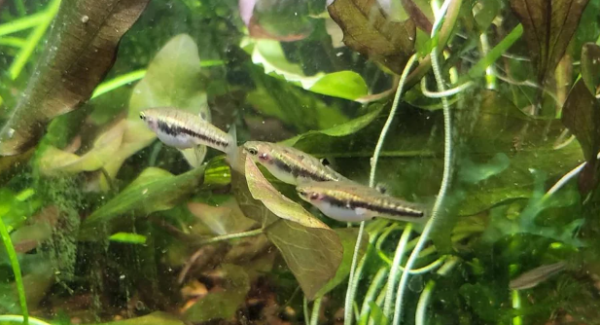
| Information Chart | Least Killifish |
| Scientific Name: | Heterandria formosa |
| Family: | Poeciliidae |
| Care Level: | Easy |
| Temperament: | peaceful |
| Color: | Males display different shades of blue, green, and blue. Females are usually less vibrant. |
| Lifespan: | 2 to 3 years |
| Size: | 1 to 1.5 inches |
| Diet: | Omnivorous |
| Minimum Tank Size: | 5 gallons for a small group |
| Temperature: | 68 to 78 F |
| WaterConditions: | pH: 7.0 to 8.0Soft water hardness |
| Tank Mate Compatibility | Small, non-aggressive fish |
Smallest fish species found in the United States and among the 10 smallest fish species in the world, Least Killifish have vibrant coloration and horizontal stripes through the center of the body. Although a small species, female Killifish, with about 1.3 inches in size, grows a bit larger than the males.
Least Killifish are native to freshwater and brackish streams ranging from South Carolina, Georgia, and Florida. They also have been found in Eastern Texas. They primarily inhabit slow-moving freshwater rivers with lots of vegetation and submerged structures.
In captivity, slightly alkaline water of pH 7.0 to 8.0 and a water temperature of 68-78 degrees F is optimum to observe their livebearer breeding habits.
Small invertebrates, such as worms and crustaceans, are the primary diet of Killifish, but they also consume plant matter.
Also Read: Galaxy Rasbora: Full Care Guide, Breeding, Tank Size & Disease
FAQs
Livebearer fish species give birth by internal fertilization. The females accept a milt of sperm from the males to fertilize and hatch the eggs within them. Fully capable fry are born after the gestation period.
Livebearer fishes are prolific breeders. Given optimum water temperature and conditions, they’ll enthusiastically breed and give birth to juvenile fishes.
Different livebearer fish species have different gestation periods. 21-30 days of gestation period is most common among aquarium livebearers.
The Bottom Line
We’ve discussed the top 10 livebearer fish that you can breed in your aquarium. Hopefully, you’ll now be able to take care of your tiny friends and help them grow their family.
No related posts.

